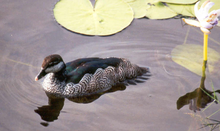Pygmy geese are a group of very small "perching ducks" in the genus Nettapus which breed in the Old World tropics. They are the smallest of all wildfowl. As the "perching ducks" are a paraphyletic group,[2] they need to be placed elsewhere. The initially assumed relationship with the dabbling duck subfamily Anatinae[citation needed] has been questioned, and it appears they form a lineage in an ancient Gondwanan radiation of waterfowl, within which they are of unclear affinities.[3] An undescribed fossil species from the late Hemphillian (5.0–4.1 mya) of Jalisco, central Mexico, has also been identified from the distal end of a tarsometatarsus. It is only record of the genus in the New World.[4]
| Pygmy geese | |
|---|---|

| |
| Green pygmy goose | |
| Scientific classification | |
| Domain: | Eukaryota |
| Kingdom: | Animalia |
| Phylum: | Chordata |
| Class: | Aves |
| Order: | Anseriformes |
| Suborder: | Anseres |
| Superfamily: | Anatoidea |
| Family: | Anatidae |
| Genus: | Nettapus Brandt, 1836 |
| Type species | |
| Anas madagascariensis[1] = Anas aurita Gmelin, 1789 | |
| Species | |

| |
| Distribution
N. auritus
N. c. coromandelianus
N. c. albipennisauritus
N. pulchellus
| |
The genus Nettapus was erected by the German naturalist Johann Friedrich von Brandt in 1836.[5] The name is from Ancient Greek nētta meaning "duck" and pous meaning "foot". It was thought that the type species, the African pygmy goose (Nettapus auritus), possessed the feet and body of a duck and the neck of a goose.[6]
There are three extant species in the genus:[7]
| Image | Scientific name | Common Name | Distribution |
|---|---|---|---|
 |
Nettapus auritus | African pygmy goose | Sub-Saharan Africa |
 |
Nettapus coromandelianus | Cotton pygmy goose | northern Australasia and Southeast Asia |
 |
Nettapus pulchellus | Green pygmy goose | northern Australia and southern New Guinea |
Pygmy geese have short bills, rounded heads and short legs. They nest in tree holes.